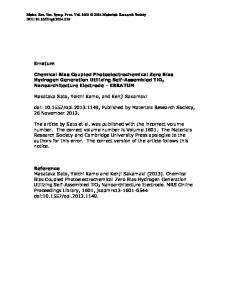ZnO-CdZnS Core-Shell Nanocable Arrays for Highly Efficient Photoelectrochemical Hydrogen Generation
- PDF / 686,835 Bytes
- 6 Pages / 612 x 792 pts (letter) Page_size
- 76 Downloads / 301 Views
1256-N16-03
ZnO-CdZnS Core-Shell Nanocable Arrays for Highly Efficient Photoelectrochemical Hydrogen Generation Yoon Myung, Dong Myung Jang, Yong Jei Sohn, Tae Kwang Sung, Gyeong Bok Jung, Yong Jae Cho, Han Sung Kim, and Jeunghee Park* Department of Materials Chemistry, Korea University, Jochiwon, 339-700, Korea, Republic of ABSTRACT High-density TiO2-CdS and ZnO-CdS core-shell nanocable arrays were synthesized on largearea Ti substrates. The CdS layers were deposited on the pre-grown vertically-aligned TiO2 (rutile) and ZnO nanowire arrays, with a controlled thickness (10~50 nm), using the vapor transport method. The ZnO-CdS nanocables consisted of single-crystalline wurtzite CdS shells whose [001] direction was aligned along the [001] wire axis of the wurtzite ZnO core, which is distinctive from the polycrystalline shell of the TiO2-CdS nanocables. We fabricated the photoelectrochemical cell using the ZnO-CdS photoelectrode exhibits much more efficient hydrogen generation than that using the TiO2-CdS one. INTRODUCTION Solar-hydrogen (H2) production from water is fast becoming a vital source of renewable energy and is being developed as an alternative to traditional fossil fuel-based sources of power. Generally, this process utilizes a semiconductor material as a photocatalyst, in order to transfer the solar energy for the production of H2 from water. One promising device for inexpensive, large-scale solar energy conversion is the TiO2-based photoelectrochemical cell (PEC), which was first discovered by Fujishima and Honda using UV irradiation.1 In order to improve the performance of PECs in the visible light region, the development of smaller band gap materials or new architectures is required, which represents a serious technological challenge. In particular, novel photoelectrodes in which arrays of TiO2 or ZnO one-dimensional (1-D) nanostructures (e.g., nanorods, nanowires, or nanotubes) are grown on a conducting substrate are emerging as an alternative to nanocrystalline TiO2 films.2-3 They can help to improve the electron transport by avoiding the particle-to-particle hopping that occurs in the TiO2 network. Furthermore, their 1-D nanostructure morphology can increase the likelihood that all photogenerated electrons have a direct connection to the collection electrode. In previous studies, they were photosensitized with various semiconductor nanocrystals (or quantum dots), e.g. CdS,4 CdSe,5 CdTe,6 and ZnSe.7 showing efficient photocurrent generation under visible light irradiation. We characterized their structural and optical properties by applying a comprehensive set of techniques. PECs were also designed using these two types of nanocable array electrodes, to achieve photocurrent and H2 generation under visible light irradiation. We compared the charge
separation ability of the TiO2 and ZnO NW cores in the photosensitizing CdS shells, since this determines the photoconversion efficiency of the PEC. The successful achievement of such PECs would be a key step toward the demonstration of a new viable nanome
Data Loading...










